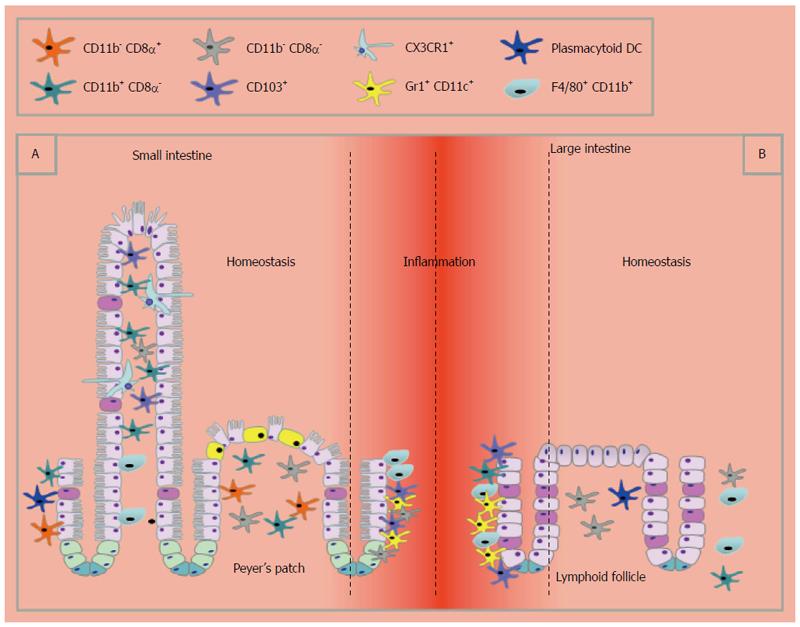Copyright
©2014 Baishideng Publishing Group Inc.
World J Gastroenterol. Nov 7, 2014; 20(41): 15216-15232
Published online Nov 7, 2014. doi: 10.3748/wjg.v20.i41.15216
Published online Nov 7, 2014. doi: 10.3748/wjg.v20.i41.15216
Figure 2 Schematic representation of the distribution of dendritic cell and macrophage subset in the small and large intestine under homeostatic conditions and upon inflammation.
In homeostasis dendritic cells (DCs) and macrophages are found in close contact with the epithelium in the small intestine (A) whereas in the large intestine they are rare and in the LP (B) and are recruited in response to inflammatory stimuli. Within the small intestine lymphoid resident DC (CD11chigh, MHCIIhigh CD64-) can be grouped into CD8α+, CD11b+ and CD8α-CD11b- DCs, which are located in Peyer’s patches. In the lamina propria (LP) of the small intestine CD11b+CD8α- DCs predominate. CD8α-CD11b- DCs have been identified in regions of the large intestine, including the ILFs, but CD11b-CD8α+ DCs are rarely found during homeostasis. Plasmacytoid B220+ CD11cintermediate DC are present in very low numbers in the LP of the small intestine and ILFs of the large intestine. In the small intestine CX3CR1+ cells can produce transepithelial dendrites that extend through the epithelium to directly sample luminal contents. This has not been demonstrated in the large intestine during homeostasis. In addition to CX3CR1, macrophages can be further defined by expression of CD11b, F4/80 and CD64. Upon inflammation, Gr1+ monocyte-derived inflammatory DCs accumulate in both the small and large intestine.
- Citation: Bowcutt R, Forman R, Glymenaki M, Carding SR, Else KJ, Cruickshank SM. Heterogeneity across the murine small and large intestine. World J Gastroenterol 2014; 20(41): 15216-15232
- URL: https://www.wjgnet.com/1007-9327/full/v20/i41/15216.htm
- DOI: https://dx.doi.org/10.3748/wjg.v20.i41.15216









